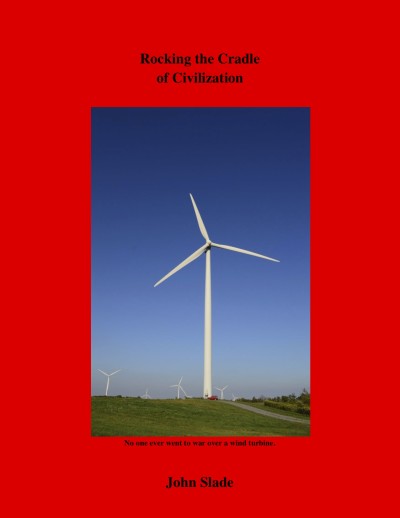
Rocking the Cradle of Civilization
Available at: Amazon
Prairie Wind is fiercely determined, as a student, as a bride, as a young mother, to restore the health of Mother Earth, and to build a Global Generation unprecedented in human history.
Her story—your story—is about our world today.
She hopes that you will join her.
Because she is going to win.
Sample chapters from Rocking the Cradle of Civilization
- Chapter Six, The Cradle of Civilization and the Holocene
- Chapter Thirty-Three, The Kelp Forests
- Chapters Fifty-Three and Fifty-Four, Prairie Wind and her Lakota Sioux People
- Chapters Seventy-Seven and Seventy-Eight, Depression
- Chapter Eighty, Mother Humpback Whale and Calf
- Chapter Ninety-Five, To Relinquish
A synopsis of the novel
I would like to put into your hands a story about a young woman deeply committed, in her own unique way, to restoring our battered planet to the level of health which has enabled life to live here for three and a half billion years. She is Prairie Wind, a Lakota Sioux from the Rosebud Reservation in South Dakota, who aches in her heart because the buffalo which once thundered in immense herds across the prairie . . . were slaughtered almost to extinction.
Prairie Wind knows as well that her Lakota people were slaughtered almost to extinction. Whereas other children in America visit Disney World, Prairie Wind and her classmates visited the mass grave at Wounded Knee.
Raised on the Rosebud Reservation as “an impoverished outcast”, an unwanted orphan in America, she nevertheless shows an early talent for mathematics. With guidance from her grandmother, Prairie Wind understands that the equations which describe the workings of the vast galaxies, as well as the workings of tiny atoms, are clear evidence of a Creator. Her high school mathematics teacher encourages her to apply to Stanford University in California; she is accepted with a scholarship, and will thus begin a new life, far from the Rosebud where her people share the barren land with rattlesnakes.
Prairie Wind finds herself in September of 2008 at a vibrant university where her mind can grow. She quickly moves from mathematics to World History, to Black History, to the legal foundation of human rights, to an interview—when she is still a freshman—with a professor of human rights at the Stanford Law School—a Black woman from Harlem—who sees that Prairie Wind is a gifted and deeply motivated student with a unique understanding of our troubled world.
Prairie Wind meets William, an Iroquois Oneida from New York State, and a first-year student at Stanford Medical School. William understands that Prairie Wind is a true visionary in the tradition of her people, able to take a lecture on the Cradle of Civilization in the Fertile Crescent, a lecture on the U. S. Constitution and the Bill of Rights, a lecture on the Civil Rights Movement in Birmingham, Alabama, and lecture on the melting of the Arctic ice cap . . . and to put it all together not so she can pass the exams, but so she can see the Big Picture, on a planetary scale. And so that she can ponder how all of us . . . can move forward to a far better world.
Following her freshman year, Prairie Wind spends the summer at Stanford’s Pacific Marine Research Center on Monterey Bay, learning from the experts about the warming Arctic, the kelp forests, the coral reefs, and the warming of the Antarctic. She draws out from her professors not only their knowledge of marine biology, but also their innermost feelings about the ocean world which they love . . . and now see increasingly threatened by the warming of the planet.
She and William spend two weeks camping beside Cathedral Lake in Yosemite National Park. Because the ghosts of her Native American people are always with her, she and William probe deep into the near extinction of the Native Americans who once lived in Yosemite, and in all of California, during the Gold Rush and the early years of California statehood.
In August of 2009, Prairie Wind and William are married on the Rosebud Reservation, embraced by the Lakota spirit of her people.
After eight years at Stanford, Prairie Wind has an undergraduate degree, a law degree, and a PhD in human rights. William has his medical degree, and has worked for four years through his internship and residency.
With their degrees, and with prompting from friends and family, the exhausted students spend three months with Polynesian friends on the island of Mo’orea, sister island to Tahiti in the South Pacific. They discover—for the first time in their lives— a place where two cultures, Polynesian and French, merge together with harmony and respect. The vibrant indigenous language is spoken just as much as French, the Tahitian culture is celebrated with a yearly festival, and the creatures of the sea are protected by the laws of the marine sanctuary which extends throughout French Polynesia. Both Prairie Wind and William feel liberated from the racial oppression which they felt daily in America. She is pregnant, in her second trimester during these three months, and thus she is thinking deeply about the world in which her Little One will grow up.
* * *
In September of 2016, they confront life in contemporary America when they move into their new home on the Rosebud Reservation in South Dakota, she as a lawyer and he as a doctor. They join a gathering of Native Americans on a nearby reservation, where the Standing Rock Sioux are protesting the construction of an oil pipeline across their sacred burial grounds and beneath the nearby Missouri River. Trump stuns the world when he is elected President in November. While William treats the victims of tear gas and rubber-coated steel bullets, Prairie Wind struggles to defend the legal rights of her people. Surrounded by a resurgence of American racism and violence, Prairie Wind gives birth—William, an obstetrician, is her doctor—to their first child just before Christmas of 2016.
What sort of world does this child inherit?
We follow the story to the election in November of 2020, the riot in the Capital in January of 2021, Inauguration Day on January 20—when a great calm descends upon the land—to the First 100 Days of the Biden administration.
On March 15, 2021, the U.S. Senate confirms a Native American woman, Deb Haaland, as President Biden’s Secretary of the Interior. Among her responsibilities is the Bureau of Indian Affairs.
On March 16 (in the story), Prairie Wind, at home on the Rosebud, receives a phone call from the new Secretary of the Interior, who knows about Prairie Wind’s legal work for many tribes during the tumultuous Trump years. The Secretary invites Prairie Wind to work with her in Washington as a personal consultant. She invites William, who has extensive experience in several Native American hospitals, to work with the Indian Health Service.
In the final chapter, Prairie Wind and William, with their two young children, stand for a family portrait in front of the Lincoln Memorial. They are strong, they are determined, and they are full of hope.
* * * * *
Rocking the Cradle of Civilization weaves together three major themes: the Climate Crisis, racism in America, and the future role of women in America and in the world. This is an American story, but it is also a portrait of our planet.
America is now at an extremely important transition point in her history, as we move from the Trump racism and chaos . . . to Joe Biden’s bold vision for an America which reaches back to the doctrine, “All men are created equal” . . . and an America which reaches forward to a future of clean energy, prosperity, equality, and peace.
The entire planet is now at an extremely important transition point: do we work together to wrap a web of clean energy around the world . . . or do we continue to burn the oil until we are overwhelmed by drought and storms and refugees and war?
Rocking the Cradle of Civilization is a story about our world today. The intended audience is primarily American, but the global scope of the story, and of the planetary challenges which we face, make this an important book to place into the hands of people from Russia, from China, from Ethiopia, from Brazil, from Viet Nam.
I have woven 25 years of intensive climate research into Rocking the Cradle of Civilization. I trained with Al Gore as one of his Climate Reality speakers.
Dr. George Somero, a professor of marine biology at Stanford, has read most of the chapters. The scientific facts in this novel are absolutely accurate.
During my career as an English teacher, I spent two years working with the Sami reindeer people above the Arctic Circle in the heart of the tundra in northern Norway. As I taught my vibrant Sami students how to write an essay in English (so that they could write to other indigenous peoples around the world), they gave me my first lessons about global warming . . . as the snow turned to rain on the tundra, the seasons shifted, and both their reindeer herds and their ancient Sami culture were threatened by the pollution from the South.
Rocking the Cradle of Civilization delivers the Big Picture with crystal-clear writing. The story reaches around the planet as it portrays the Renaissance which could transform the 21st Century.
This is the book that a billion young people around the world are waiting to read.
* * * * * *
Book categories: Climate Change and Clean Energy
